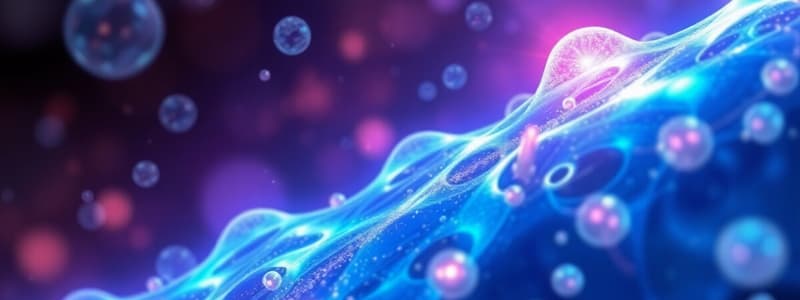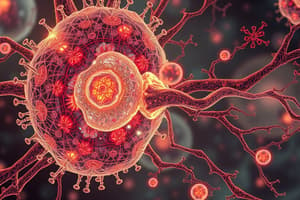Podcast
Questions and Answers
What role do secondary messengers play in signal transduction?
What role do secondary messengers play in signal transduction?
- They inhibit the action of primary messengers.
- They act as the main receptors for cellular ligands.
- They transmit information further downstream. (correct)
- They are responsible for the removal of local signals.
What is primarily responsible for phosphorylation in cellular signaling?
What is primarily responsible for phosphorylation in cellular signaling?
- G protein-coupled receptors
- Phosphatase family of enzymes
- Ligand-gated ion channels
- Kinase family of enzymes (correct)
What characterizes cell-surface receptors?
What characterizes cell-surface receptors?
- They can only bind to non-hydrophilic molecules.
- They only respond to small molecular weight ligands.
- They require crossing the plasma membrane to transmit signals.
- They consist of multiple domains including an extracellular ligand-binding domain. (correct)
Which of the following processes can lead to the activation of cellular responses?
Which of the following processes can lead to the activation of cellular responses?
Which type of receptor is known to directly form ion channels upon ligand binding?
Which type of receptor is known to directly form ion channels upon ligand binding?
What is the primary mechanism by which cholera induces severe diarrhea in the intestinal epithelium?
What is the primary mechanism by which cholera induces severe diarrhea in the intestinal epithelium?
Which type of receptor is primarily involved in regulating cell growth and metabolism through tyrosine kinase activity?
Which type of receptor is primarily involved in regulating cell growth and metabolism through tyrosine kinase activity?
What triggers the dimerization of Receptor Tyrosine Kinases (RTKs)?
What triggers the dimerization of Receptor Tyrosine Kinases (RTKs)?
In the context of Pertussis toxin, what is the outcome of its effect on the Gi subunit?
In the context of Pertussis toxin, what is the outcome of its effect on the Gi subunit?
Which type of receptor responds by autophosphorylating serine or threonine residues upon ligand binding?
Which type of receptor responds by autophosphorylating serine or threonine residues upon ligand binding?
Which effect does the stimulation of influx of chloride through GABA receptor A achieve?
Which effect does the stimulation of influx of chloride through GABA receptor A achieve?
How does the modulation of Gi proteins affect blood pressure in hypertension?
How does the modulation of Gi proteins affect blood pressure in hypertension?
What is the primary action of drugs acting on β2 adrenergic receptors?
What is the primary action of drugs acting on β2 adrenergic receptors?
What is the role of Gq proteins in response to α1 adrenergic receptor activation?
What is the role of Gq proteins in response to α1 adrenergic receptor activation?
Drugs targeting enzyme-linked receptors are primarily used for which purpose?
Drugs targeting enzyme-linked receptors are primarily used for which purpose?
What is the primary consequence of gene mutations in chloride channels related to Cystic Fibrosis?
What is the primary consequence of gene mutations in chloride channels related to Cystic Fibrosis?
Which characteristic is shared by all G protein-coupled receptors?
Which characteristic is shared by all G protein-coupled receptors?
What is the function of the Gs protein subunit in G protein signaling?
What is the function of the Gs protein subunit in G protein signaling?
What results from the action of cholera toxin on G proteins?
What results from the action of cholera toxin on G proteins?
What is a characteristic of ligand-gated ion channels?
What is a characteristic of ligand-gated ion channels?
Flashcards
Secondary Messengers
Secondary Messengers
Molecules that transmit signals within a cell, often triggered by external signals.
Signal Transduction Cascade
Signal Transduction Cascade
A series of biochemical reactions inside a cell that convert an external signal into a cellular response.
Phosphorylation
Phosphorylation
The addition of a phosphate group to a protein, often to activate or deactivate it.
Ligand-Gated Ion Channels
Ligand-Gated Ion Channels
Signup and view all the flashcards
Cell-Surface Receptors
Cell-Surface Receptors
Signup and view all the flashcards
Cystic Fibrosis
Cystic Fibrosis
Signup and view all the flashcards
G Protein-Coupled Receptors (GPCRs)
G Protein-Coupled Receptors (GPCRs)
Signup and view all the flashcards
G protein
G protein
Signup and view all the flashcards
Cholera toxin
Cholera toxin
Signup and view all the flashcards
Cholera's mechanism of diarrhea
Cholera's mechanism of diarrhea
Signup and view all the flashcards
Pertussis toxin effect on airway epithelium
Pertussis toxin effect on airway epithelium
Signup and view all the flashcards
Enzyme-linked receptors
Enzyme-linked receptors
Signup and view all the flashcards
Receptor Tyrosine Kinase (RTK) activation
Receptor Tyrosine Kinase (RTK) activation
Signup and view all the flashcards
RTK downstream signaling
RTK downstream signaling
Signup and view all the flashcards
Nicotinic Receptor Modulation
Nicotinic Receptor Modulation
Signup and view all the flashcards
GABA Receptor Modulation
GABA Receptor Modulation
Signup and view all the flashcards
Gs Protein Activation
Gs Protein Activation
Signup and view all the flashcards
Gi Protein Inhibition
Gi Protein Inhibition
Signup and view all the flashcards
Gq Protein Activation
Gq Protein Activation
Signup and view all the flashcards
Study Notes
Signaling Across Biomembranes
- Signals from cells are mostly chemicals released into the extracellular fluid
- Signals can be transported to distant targets (endocrine), adjacent cells (paracrine), or the same cell (autocrine)
- Signaling conveys information to target cells, influencing processes like metabolism, gene expression, cell division, and differentiation
- Cell signaling has three stages: reception, transduction, and response
- Reception: A cell recognizes a signal molecule (ligand) by a specific protein (receptor) on its surface or within the cytosol or nucleus
- Transduction: The binding of ligand to receptor initiates a cascade of events that amplify or integrate the signal
- Response: The final step in signal transduction that produces a cellular response, such as contraction, secretion, or metabolic reaction.
- Membrane receptors bind ligands outside the cell without crossing the plasma membrane. These include ligand-gated ion channels, G protein-coupled receptors, and enzyme-linked receptors.
- Ligand-gated ion channels allow ions to cross the membrane in response to ligand binding, rapidly changing cellular response.
- G protein-coupled receptors (GPCRs) are a large receptor family that use G-proteins to transmit signals inside the cell.
- Enzyme-linked receptors transmit signals through intracellular enzymes, like receptor tyrosine kinases (RTKs). These are involved in many cell growth and development processes.
- Receptor proteins can be categorized by their structure and methods of signaling.
- Phosphorylation/dephosphorylation regulate proteins involved in signal transduction.
Drug Modulation of Cell Signaling
- Drugs can modulate cell signaling through various mechanisms, including acting on receptors, enzymes, or ion channels.
- Drugs can act outside the cell membrane, on cell surface receptors, and on intracellular receptors.
- Drugs can modulate diverse cellular functions by binding in place of ligands, altering ion flow in ion channels, affecting intracellular second messengers, inhibiting/activating downstream signaling pathways, or directly regulating the receptor expression.
- Drugs can bind to receptors:
- As agonists (mimicking natural ligands), triggering a cellular response
- As antagonists (blocking natural ligands), preventing a cellular response
- Drugs can also be inverse agonists (reverse the signaling).
- A graded dose-response curve plots the relationship between drug concentration and response.
- Drugs can be categorized as competitive reversible or competitive irreversible antagonists based on their binding.
- Drugs can also be non-competitive or allosteric antagonists that bind to a different site on the receptor.
- Important considerations about drug affinity and potency in targeting biological pathways are required.
Studying That Suits You
Use AI to generate personalized quizzes and flashcards to suit your learning preferences.




